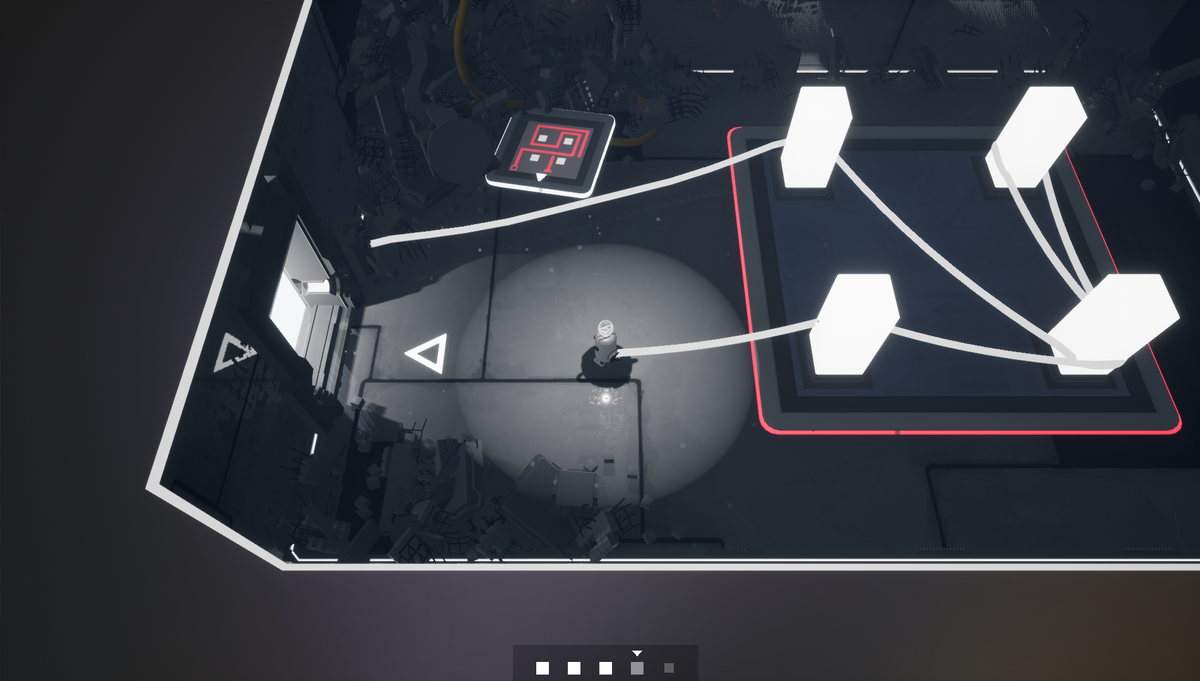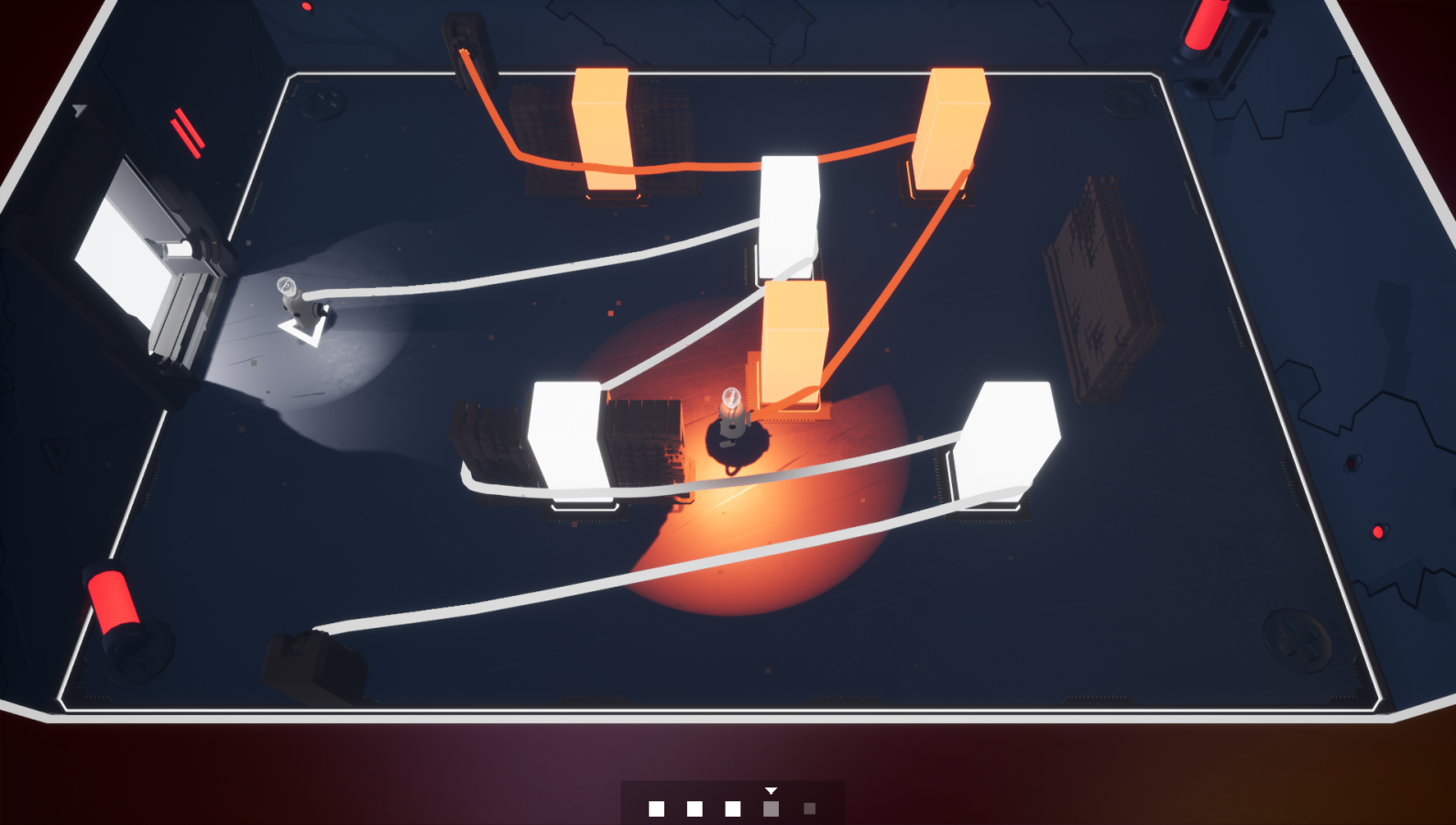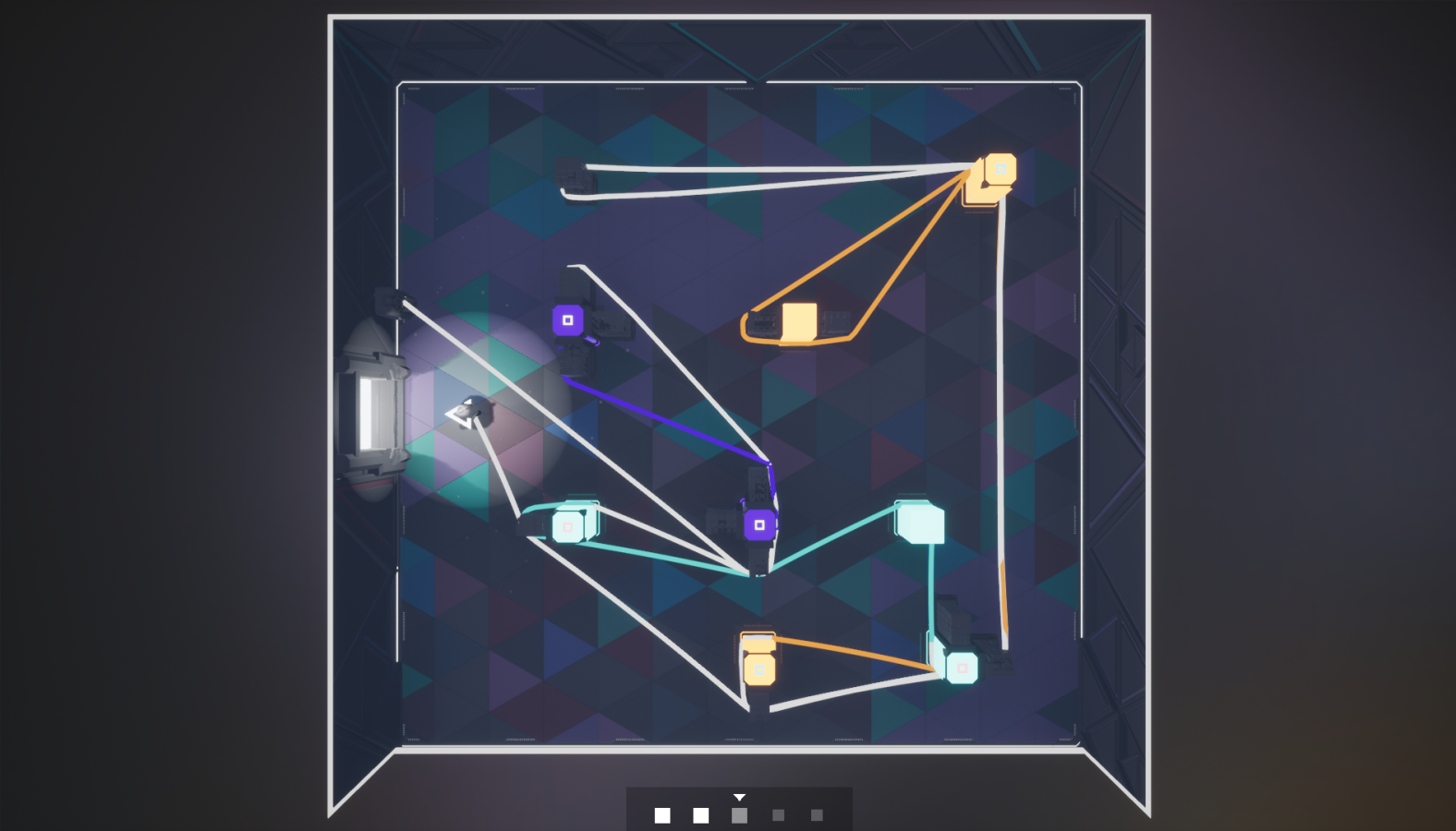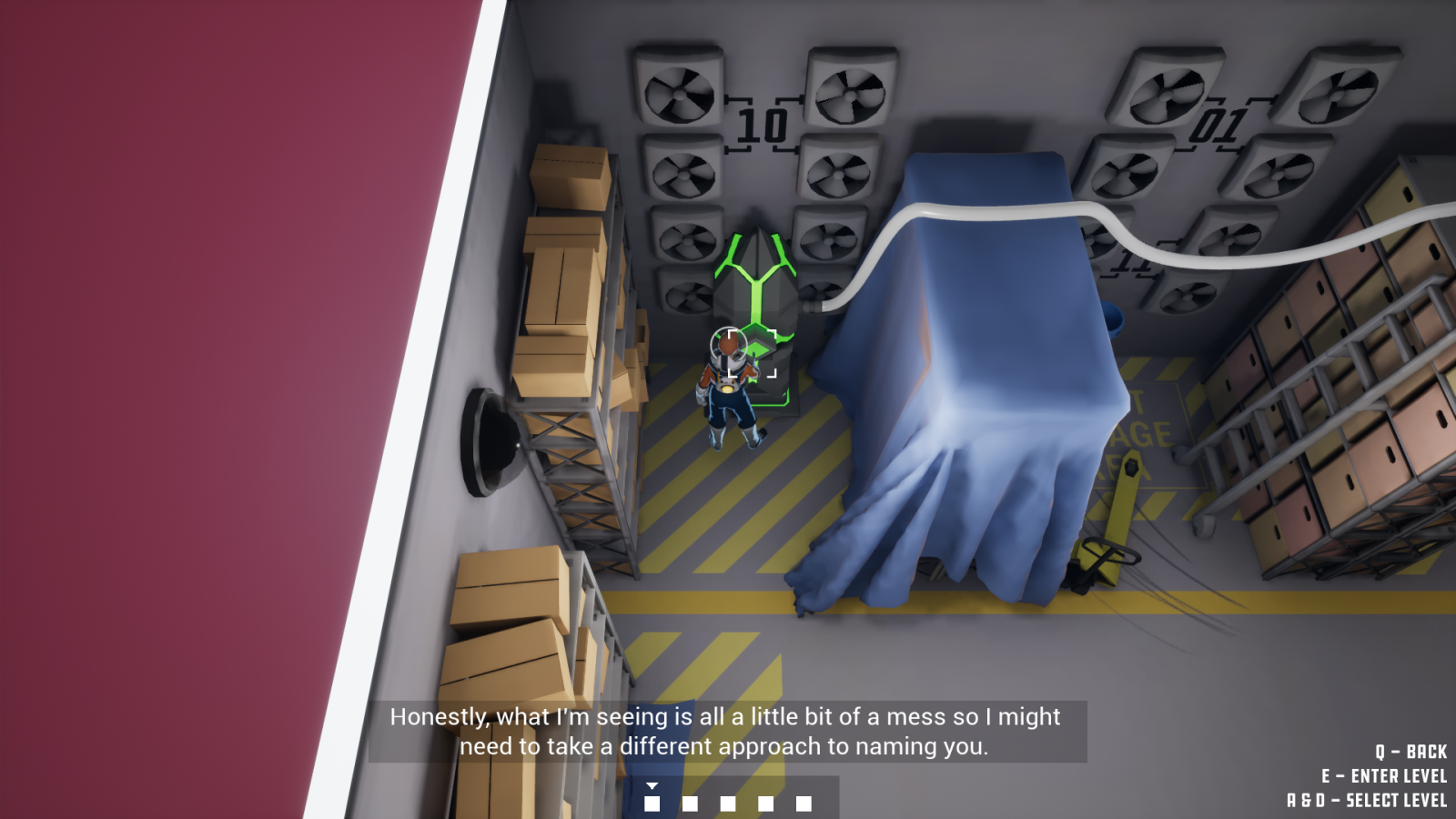
Puzzle games come in all shapes and sizes, whether they be matching tiles, connecting paths, navigating mazes, and so on. This leaves the genre open to a plethora of designs, making them more accessible to a wide variety of gamers. The biggest aspect to consider is how easy or hard the puzzles are to solve; make them too easy and it’s boring, but make them too hard and it gets frustrating. The makers of Filament clearly didn’t want it to fall into the former category, but that unfortunately pushed it too far in the opposite direction. At its core, it’s a clever and challenging puzzle game that rewards the player with information about the stranded spaceship that they are investigating.
As previously mentioned, you are investigating a spaceship called the Alabaster to figure out what happened to its crew. Almost immediately after arriving, you hear the voice of one of the crew over the intercom. The crew member, Juniper, is apparently the only remaining member of her crew on the ship due to some sort of door malfunction in the cockpit. Something went wrong and caused her to get locked in the room indefinitely. This begs the questions of where the others went and why they would leave without their friend. You’ll have to play through the game and reach the end to find out.

Besides the stuff that you’re told upfront, you gain bits of background information on the crew as you go around solving puzzles, picking up their personal belongings, and even finding keycards that you can insert into any of the computers in order to read their logs. I’ll admit that not all of the information you get is important to the plot; there’s a good mixture of plot relevance and character building thrown in. Getting to know more about the individual crew members’ roles, personalities, concerns, etc. helps you immerse yourself into the situation more. When you learn more about them, even if it’s only in text form or Juniper telling you a story, it makes you care about what happened to them. If Pistachio was just a name, why would you care? On the other hand, if you know Pistachio was a kind-hearted woman who loved plants and had a close bond with Juniper, that changes things, doesn’t it?
The gameplay focuses on a top-down view of the ship as you, lovingly named Pluto by Juniper, walk around and explore. The ship is fairly big, consisting of three levels and around two dozen rooms. You can go just about anywhere on the ship from the beginning, which is freeing and a nice change of pace. Along with that, you can solve the game’s puzzles in almost any order you like. There are pods called anchors scattered around the ship that act as your puzzle terminals. If they glow white, no puzzles have been solved in that anchor, if they glow yellow, you’ve solved at least one, and if they glow green, then you’ve finished that anchor. Offline anchors are black because they haven’t been powered yet; they gain power by completing the previous anchor that is connected to them via a long cable. This is the only real limit to what puzzles can and can’t be solved at any given time. Besides that, feel free to explore and solve in any order you like. If you get stuck, just go find another anchor and come back later.

Although there are around 300 puzzles, they all follow one basic concept. You control one or more robots that are tethered to a starting point in the levels. The levels have light pillars that must be activated by having the tether touching them. Once all light pillars are powered, the exit opens and you can walk out. The pillars must stay powered or else the exit shuts. Since you’re tethered, this means that you must choose your paths carefully in order to not only power the pillars, but also leave a way out for yourself. If you power the pillars but can’t leave, then you have to find a new way to solve the puzzle. That quickly becomes one of the biggest challenges throughout the game’s puzzles. It can be annoying to work around, but that’s part of the challenge.
Speaking of challenge, the variety of puzzle types in Filament is more than I expected. They start off easy with one robot trying to power white pillars, but become beasts of their own later on. For example, some puzzles add one or two other robots that must power their own pillars alongside the original robot, all while not getting in each others’ way. Other mechanics include having to touch certain pillars an exact specified number of times to power them, adding in black pillars that disable power when touched by the tether, having colored pillars that change the color of the tether temporarily, and more.

I felt proud whenever I was able to solve any of these tough puzzles, but that pride slowly faded as they got harder and harder. They got so difficult that I essentially hit a wall after completing as many of them as I could on my own. I couldn’t wrap my head around a great deal of the puzzles and had to take breaks from the game as a result. Thankfully, I got puzzle solutions from the developers so I could continue my journey and reach the end of the game. I’m not proud to admit that I needed that much help, but I did what I could and even I am willing to accept the limits of my problem-solving skills. At the same time, I don’t believe that it’s entirely my fault; the difficulty of later puzzles share blame as well. When looking at the solutions to the puzzles I was stuck on, I didn’t have any “wow, how did I not think of that?” moments. They get so complex and sometimes involve amounts of backtracking that you wouldn’t believe. I’m not sure if I would’ve ever solved many of those without spending hours upon hours thinking them through. Don’t get me wrong, I love a good challenge, but there have to be limits. At the very least, I think some type of hint function would be useful. Even if it doesn’t blatantly give the solution, there should be something in place to help more casual players progress to the end of the game. I don’t like giving the “it’s too hard” criticism, but a puzzle game shouldn’t be tough enough to make you want to stop playing entirely.
Okay, difficulty aside, I want to say that I adore the game’s setting. The ship feels like it’s been lived in recently, but you get that feeling of emptiness at the same time. You see how a crew had built a life there together, which makes the hollowness of the situation more troubling. You want to know why they left this home behind. The voice acting, even if it’s only Juniper talking, is very well done. Everything from her nostalgic stories to her anxiousness to her sadness all feel real. Juniper has been alone for some time and you can pick up on that from how she talks to you. It made listening to everything she said more endearing and relatable.

Now, even with the intense difficulty of many puzzles later in the game, I had an enjoyable journey with Pluto and Juniper. I still wanted to discover what happened to the crew, even if it meant using a puzzle solution guide to do so. It dampened the fun, but it needed to be done. I would finally see Juniper face to face and get my answers… or at least that was the plan. To be honest, I’m not entirely sure what happened at the end. Based on Juniper’s recounting of events, a ton of information I gathered from the logs, and what I experienced at the end of the game, I have a guess at what happened. There isn’t a blunt “this is what happened” answer, unless I missed something in the logs and am misunderstanding. Without spoiling specifics, Juniper gives you a speech of sorts before you make your way to a specified location. After playing out the last section, the credits start and that’s it. It’s an ending that leaves it up to the player to realize what’s going on, and as much as I like the idea, I was left confused and frankly unsatisfied by how things ended. Hopefully it’s just me and there’s a more concrete answer that I missed along the way.
All that being said, Filament offers a ton of challenging puzzles for anyone who wants to test their problem-solving skills. Just be warned that they ramp up in difficulty and may stump even veteran puzzle gamers. The premise and world-building are engaging, even if the end of the story leaves you to figure out what happened on your own. I wouldn’t recommend it to casual puzzle gamers or anyone who wants a relaxing game to wind down with. If all of that sounds appealing to you, then get ready to board the Alabaster.
Filament
Good
Filament offers around 300 puzzles ranging from easy to extremely challenging, with some being mind-boggling. With a variety of puzzle mechanics used, gameplay is kept from getting repetitive. Investigating the happenings of the crew is interesting, although the ending is potentially vague and confusing.
Pros
- Learning about the crew and prior events is interesting
- Puzzles are inventive and offer a variety of mechanics
- Freedom to solve puzzles in almost any order is refreshing
Cons
- Many puzzles later in the game get too complex and convoluted
- The ending isn't completely clear and requires reading through the logs
